NVIDIA GeForce GTX 770 Review: The $400 Fight
by Ryan Smith on May 30, 2013 9:00 AM ESTAlthough GTX 770 is already a very high clocked part for GK104, we still wanted to put it through its paces when it comes to overclocking. Of particular interest here is actually memory overclocking, as this is the first video card shipping with 7GHz GDDR5 standard. This will let us poke at things to see just how far both the RAM itself and NVIDIA’s memory controller can go.
Meanwhile the switch to GPU Boost 2.0 for GTX 770 is going to change the overclocking process somewhat compared to GTX 680 and GTX 670. Overvolting introduces marginally higher voltages and boost bins to play with, while on the other hand the removal of power targets in favor of TDP means that we only get 106% – an extra 14W – to play with in TDP limited scenarios. Thankfully as we’ve seen we’re generally not TDP limited on GTX 770 at stock, which means our effective headroom should be greater than that.
| GeForce GTX 770 Overclocking | ||||
| Stock | Overclocked | |||
| Core Clock | 1046MHz | 1146MHz | ||
| Boost Clock | 1085MHz | 1185MHz | ||
| Max Boost Clock | 1136MHz | 1241MHz | ||
| Memory Clock | 7GHz | 8GHz | ||
| Max Voltage | 1.2 | 1.212v | ||
We’re actually a bit surprised we were able to get another 100MHz out of the GPU itself. Even without the extra overvoltage boost bin, we’re still pushing 1200MHz+ on 1.2v, which is doing rather well for GK104. Of course this is only a 9% increase in the GPU clockspeed, which is going to pale in comparison to parts like GTX 670 and GTX 780, each of which can do 20%+ due to their lower clockspeeds. So there’s some overclocking headroom in GTX 770, but as to be expected it's not a lot.
More interesting however is the memory overclock. We’ve been able to put another 1GHz on 6GHz GTX 680 cards in the past, and with the 7GHz base GTX 770 we’ve been able to pull off a similar overclock, pushing our GTX 770 to an 8GHz memory clock. The fact that NVIDIA’s memory controller can pull this off is nothing short of impressive; we had expected there to be some headroom, but another 14% is beyond our expectations. At this clockspeed the GTX 770 has a full 256GB/sec of memory bandwidth, 33% more than both a stock GTX 680 and the 384-bit GTX 580. Of course we’ll see if GTX 770 can put that bandwidth to good use.
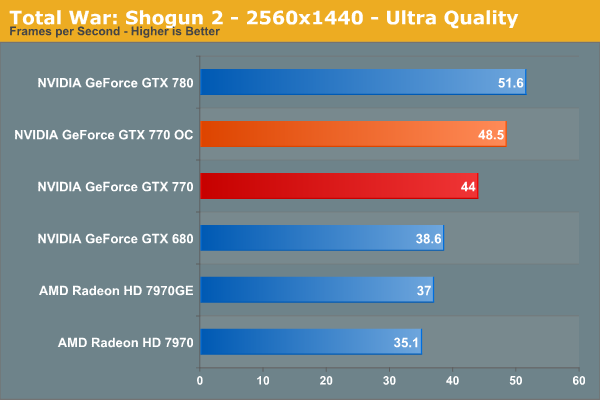
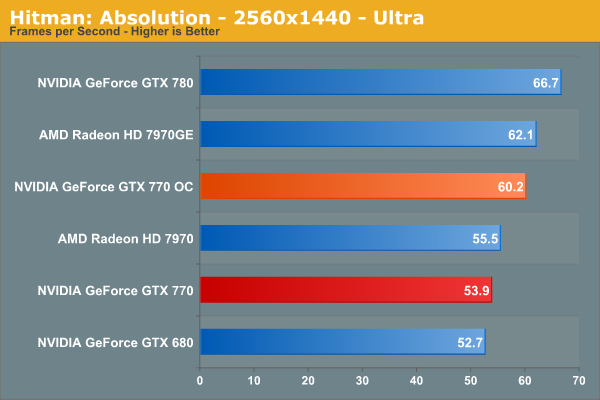
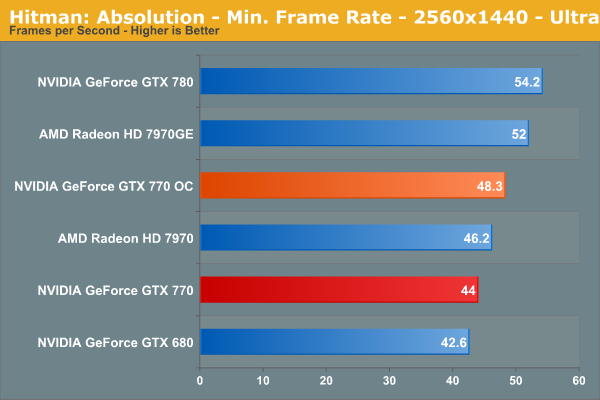
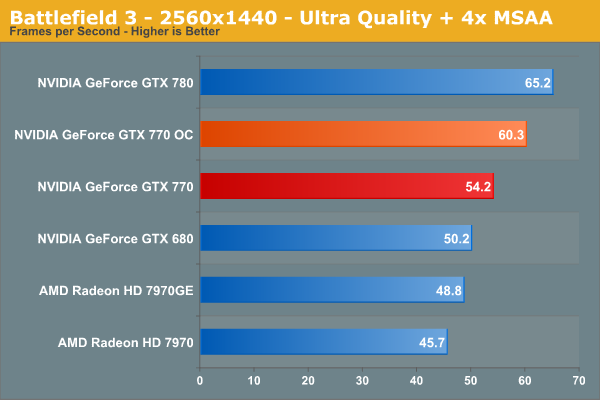
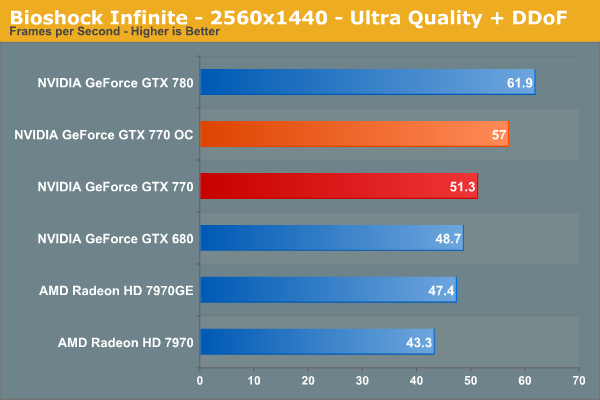
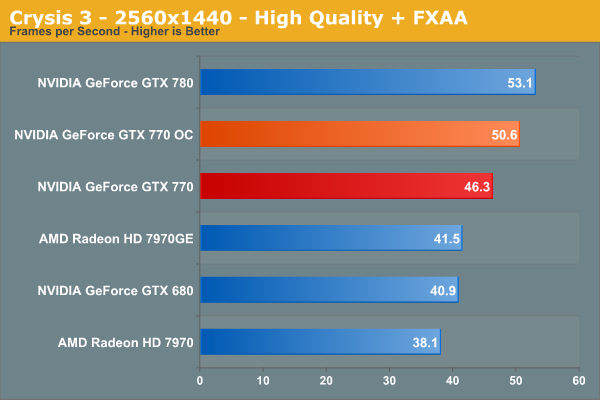
The end result of our overclocking efforts nets a very consistent 9%-12% increase in performance across our games. 9% is the upper bound for improvements due to GPU overclocking, so anything past that means we’re also benefitting from the extra memory bandwidth. We aren’t picking up a ton of performance from memory bandwidth as far as we can tell, but it does pay off and is worth pursuing, even with the GTX 770’s base memory clock of 7GHz.
Overall overclocking can help close the gap between the GTX 770 and 7970GE in some games, and extend it in others. But 10% won’t completely close the gap on the GTX 780; at best it can halve it. GTX 780’s stock performance is simply not attainable without the much more powerful GK110 GPU.
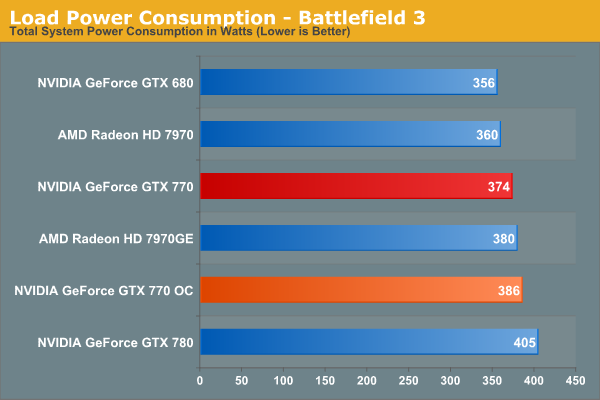
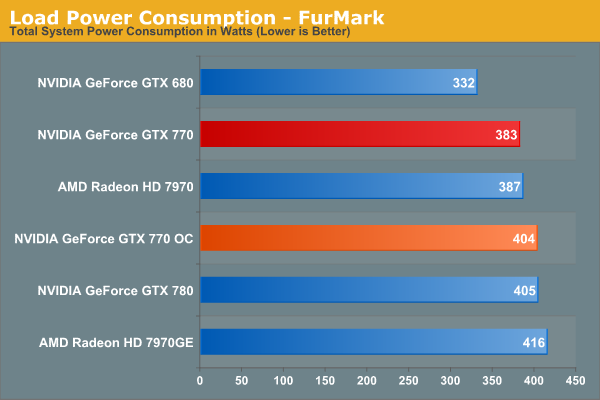
Moving on to power consumption, we can see that the 106% TDP limit keeps power usage from jumping up by too much. In Battlefield 3 this is a further 12W at the wall, and 21W at the wall with FurMark. In games this means our power usage at the wall is still below GTX 780, though we’ve equaled it under FurMark.
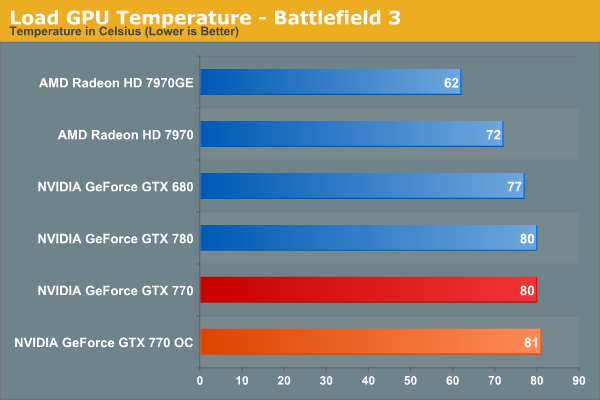
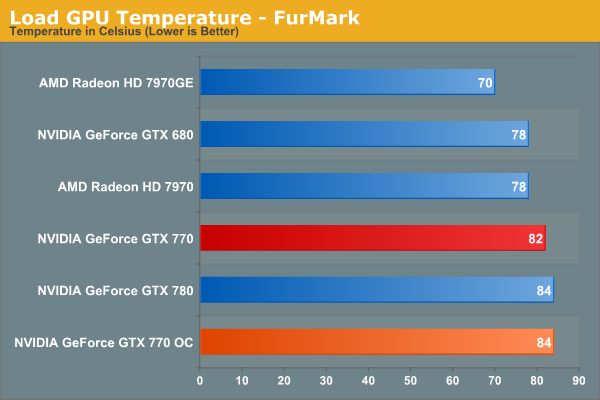
The fan curve for GTX 770 appears to be identical to that of GTX 780. Which is to say the fan significantly ramps up around 84C, keeping temperatures in the low-to-mid 80s even though GPU Boost 2.0 is allowed to go up to 95C.


Finally for fan noise, we see a small increase under Battlefield 3, and no change under FurMark. 1.5dB louder under Battlefield 3 puts noise levels on par with the GTX 780, sacrificing some of GTX 770’s abnormally quiet acoustics, but still keeping noise below the 50dB level. Or to put this another way, the performance gains for overclocking aren’t particularly high, but then again neither is the cost of overclocking in terms of noise.










117 Comments
View All Comments
djboxbaba - Thursday, May 30, 2013 - link
I'd say thats a good choice for the 1440p monitor. As far as the actual card, I agree with you that your decision should be between those 2 cards. Just as performance of the 7970GHz has increased due to driver updates, I think we can expect some performance increase from the 770 over time as well. Not sure why that was not mentioned at all in the article. If i were in your situation it would probably come down to the bundled games that come with the AMD card, do you want those games?yasamoka - Thursday, May 30, 2013 - link
No, we cannot expect performance increases from the 770 over time due to driver updates. The 770 is GK104, same architecture as the GTX680. It's just a higher-clocked 680. 680 drivers have been rolling since its release in March, it's been 14 months.The regular game-specific performance improvements will be there for both cards, for games that are coming, but we can't expect the 770 to improve in performance due to drivers as it is already a 14-month mature product (refresh), driver-wise.
EJS1980 - Thursday, May 30, 2013 - link
That makes no sense. If the 7970 has been benefiting greatly from each driver update, and its almost 6 months older than GK104, why can the 7970 improve but the 770 can't?Galidou - Saturday, June 1, 2013 - link
Wow that's a real lack of information to come up with an answer like this. 7970 was a COMPLETE remake of what had been done before. Totally justifiable that drivers improved performance like the gtx 600 series that was new. The 770 is TOTALLY a 680, physically, it's simply a GK 104 die pushed to the extreme, almost nothing new on the driver side from 680 to 770. Not that they can't improve anything but most of the job is done on the driver side of things.Stuka87 - Thursday, May 30, 2013 - link
Did you mean to say 7970Ghz? The 7950 is already at $300, has been for some time.joel4565 - Thursday, May 30, 2013 - link
Yeah I did mean 7970Ghz. Sorry for confusion.EJS1980 - Thursday, May 30, 2013 - link
I'd say forget the Dell, and go with an Overlord Tempest OC. It's the same price & panel as you'd get from Dell, except it can be overclocked to 120hz. They're a California based company, and their sales/IT departments are awesome. If you're not interested in overclocking, they sell a 60hz model for about $400. You should seriously check them out.cbrownx88 - Friday, May 31, 2013 - link
I went to their page and everything is sold out... :(Hrel - Thursday, May 30, 2013 - link
Pretty happy to see Nvidia FINALLY realize the potential of this architexture. Gives me hope for the next generation; combined with a process node drop we should see pretty impressive performance. This refresh will keep the market feeling fresh until then. I just hope they're a lot more aggressive with pricing. I know you say in the article that you were surprised by this price; but really it's still too high. It's not absurd or anything, and assuming the price drops 50+ bucks by fall it's in line with GPU market trends. But I'd like to see some price pressure FROM Nvidia, instead of AMD always being the one to kick off a price war.trajan2448 - Thursday, May 30, 2013 - link
Most of the reviews I've seen have had the 770 beating the 7970gE pretty well. It seems this site really bends over to make AMD look as good as possible, even though the 7970 uses more power and is generally slower and more expensive.